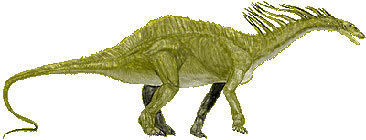Amargasaurus Casuei See map
While the Argentinosaurus Huinculensis was at least five times larger, the Amargasaurus Cazuei represents one of the most important findings of the many that have occurred in the region.
This is a sauropod (plant-eating animal) found in 1984 by paleontologist José Bonaparte of the Natural Sciences Museum in Buenos Aires in the place Las Cortaderas on a geological formation called La Amarga. The area of foothills is located approximately 80 kilometers from the city of Zapala.
 Amargasaurus Cazuei.
Amargasaurus Cazuei.The Amargasaurus, an animal that would have inhabited the region about 120 or 130 million years ago, had the peculiarity of spines on the back and head, which protected him from attack by large predators that doubled in size.
That is, was a sort of reptilian porcupine and from its finding he became the first sauropod with spines on record.
The creature would have measured between 2 and 2,5 meters high and would have six to eight meters long to reach adulthood.
The spines of the back were, in fact, an extension of the cervical vertebrae, while in the skull with a curious hole had four spines for protection. The bones of the spine measuring about 80 centimeters long, quite large if one takes into account the size of this animal.
Ten years after the discovery of the bones of the first Amargasaurus, Bonaparte repeated the expedition and found fossils of other creatures of the same species. The remains of the Amargasaurus are on display at the Olsacher Musuem in Zapala, which depends on the provincial Mining Department of the province of Neuquén.
In 1999, in a campaign that was done in Picún Leufú (Neuquén), Bonaparte found the fossil of an animal that has a certain kinship with the Amargasaurus, although somewhat younger. He was baptized, the Augustia Liguagüeño, which unlike Amargasaurus instead of spines had a kind of armor in the back.
Bonaparte is the most famous paleontologists of Argentina and in Neuquén in particular he discovered the only two species of spines and armor sauropods that are known today.
Viajes por la Patagonia
Related Articles
© Patagonia.com.ar 2025 | Todos los derechos reservados.
